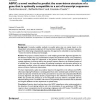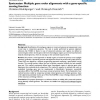102 search results - page 2 / 21 » A Novel Method for Reducing Computational Complexity of Whol... |
BMCBI
2005
13 years 5 months ago
2005
Background: Currently available methods to predict splice sites are mainly based on the independent and progressive alignment of transcript data (mostly ESTs) to the genomic seque...
BMCBI
2004
13 years 5 months ago
2004
Background: In a previous paper, we introduced MUSCLE, a new program for creating multiple alignments of protein sequences, giving a brief summary of the algorithm and showing MUS...
RECOMB
2005
Springer
14 years 5 months ago
2005
Springer
We describe a novel method for efficient reconstruction of phylogenetic trees, based on sequences of whole genomes or proteomes, whose lengths may greatly vary. The core of our me...
ALMOB
2008
13 years 5 months ago
2008
Background: Identification of homologous regions or conserved syntenies across genomes is one crucial step in comparative genomics. This task is usually performed by genome alignm...
BMCBI
2008
13 years 5 months ago
2008
Background: Detecting conserved noncoding sequences (CNSs) across species highlights the functional elements. Alignment procedures combined with computational prediction of transc...


